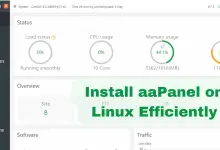Latest Added
Deals and Reviews
This Week's Popular In DTT
-
No Boot Device Windows 7

Imagine this: you sit at your computer, ready to get some work…
-
What is Debian? A Comprehensive Guide to Understanding Debian Linux

Debian is a free and open-source operating system for computers, servers, and…
-
Plc Artificial Intelligence: Advancements and Applications

PLC Artificial Intelligence (AI) is a technology that enables Programmable Logic Controllers…
-
Cyber Security Masters Europe: Top Programs and Requirements

Cybersecurity is an increasingly important field in the world of technology. With…
-
UCLA Artificial Intelligence Course: Overview and Benefits

Overview of UCLA Artificial Intelligence Course Ucla Artificial Intelligence Course: Overview And…
-
Sneaking in Cyber Security: Tips for Keeping Your Business Safe Online

Sneaking in cyber security is a growing concern for businesses and individuals…
-
Cybersecurity Honor Society: Recognizing Excellence in Cybersecurity

The Cybersecurity Honor Society is a prestigious organization that recognizes students who…
-
Smart Grid Cyber Security: Protecting the Future of Energy

Smart Grid Cyber Security is a critical topic in the energy sector…
-
Master the Steps: Install aaPanel on Linux Efficiently

Are you tired of manually configuring your server settings every time you…
Most Read
-
50 Secret Google Ranking Factors for 2023, Make Easy to Rank
Search Engine Optimization (SEO) is influenced by a multitude of factors. Addressing…
-
Fiction Books About Artificial Intelligence: A Comprehensive List
Fiction books about artificial intelligence have become increasingly popular in recent years.…
-
Digital Forensics in Cybersecurity C840: Understanding the Importance of Digital Evidence Analysis
Digital Forensics in Cybersecurity C840 is an important course that covers various…
-
NFT Business opportunities
The NFT Business is the latest topic that is sweeping the internet…
-
install aaPanel on a VPS: A Beginner’s Guide to Setting Up Your Website
Are you tired of manually setting up and managing your VPS? Look…
-
Data Science: The Key to Unlocking Business Insights
Understanding Data Science Data Science: The Key To Unlocking Business Insights Data…
-
Search Arbitrage with Native Ads: Maximizing Your Ad Revenue
Search arbitrage with native ads has emerged as a powerful marketing strategy…
-
Artificial Intelligence SVG Generator: Creating Dynamic Vector Graphics with Ease
Understanding Artificial Intelligence Svg Generator Artificial Intelligence Svg Generator is a tool…
-
Motorola One Action: A Complete Review of Features, Pros, and Cons
Looking for a balanced review of the Motorola One Action? We break…

















